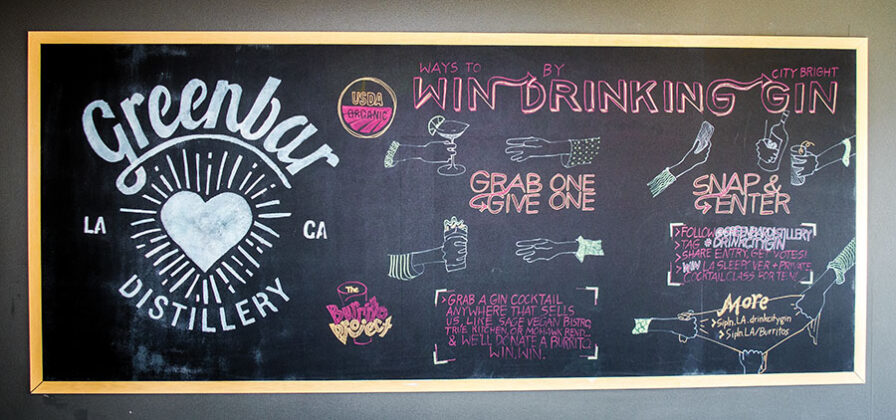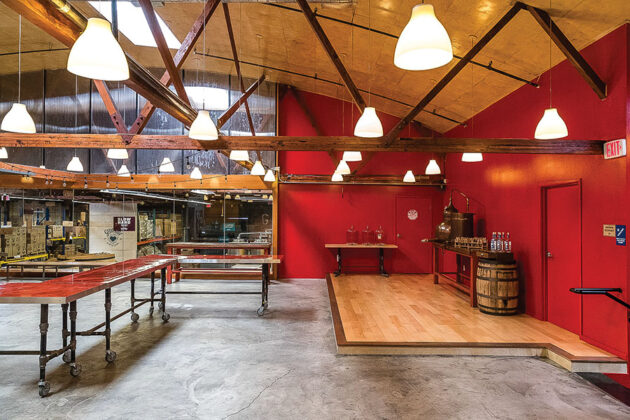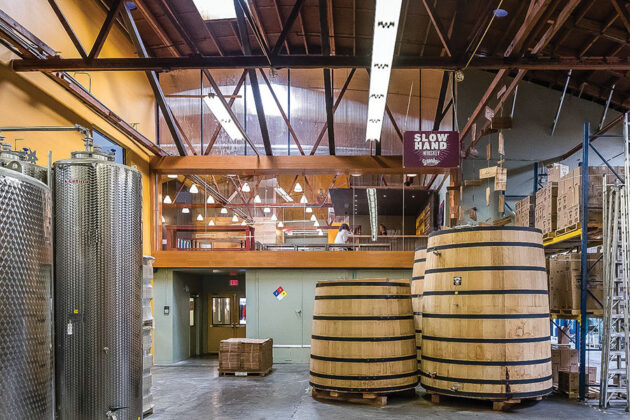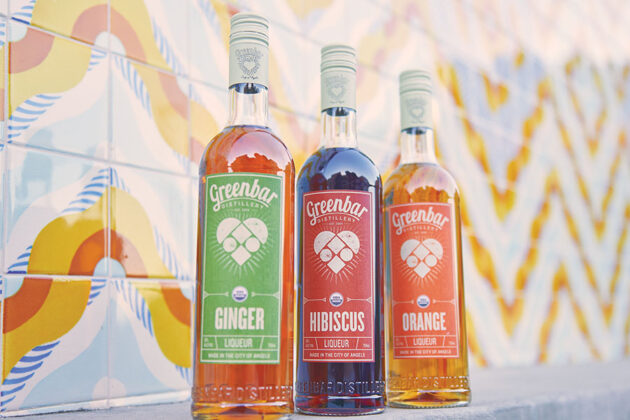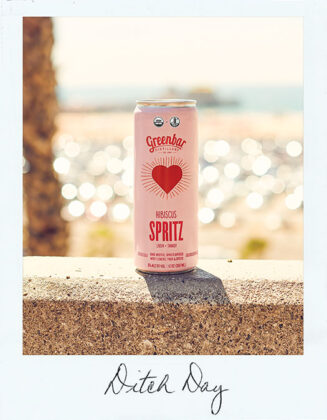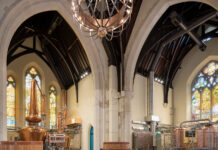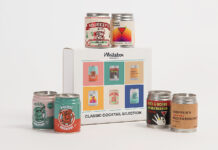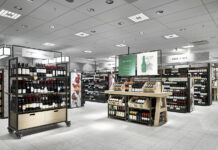“Nothing Melkon does is normal,” Joe Keeper declares. “It’s all funky, and that funk is love. Like it or dislike it, there’s no arguing that someone at Greenbar cares about every single ingredient.”
Melkon is Melkon Khosrovian, Greenbar his distillery, and Keeper’s enthusiasm for both is effusive. Keeper has sold barware and craft spirits at his Los Angeles shop, Bar Keeper, since the first stirrings of the cocktail renaissance. Over the last two decades, he has seen customers evolve from consumers to prosumers: sophisticated drinkers who are knowledgeable about spirits and well-made drinks. “Consumers don’t understand how special Greenbar’s juice is, but prosumers do.”
Greenbar Distillery, some six miles south of Keeper’s shop, fills a one-time paint warehouse shoehorned against a train yard and the vast concrete artery of the Los Angeles River. Between the stills, wooden vats, and steel and plastic lugs, pathways can accommodate, only just, a pallet jack or forklift. Barrels of spirits that once aged here have shifted off-site to permit more production space. The canning line, a recent investment of some two million dollars, claims a sizable tract of floorspace. In an era when four people could count all the American craft distilleries on their own fingers, before lawmakers and distillers themselves would come to working agreement on what a “craft distillery” even was, Greenbar was there. Above the production floor, a sign attests to its eminence: LA’s Original Distillery.

Act I: These Barbaric Drinks
When Melkon and his wife Litty Mathew began dating, they visited each other’s relatives. Melkon, whose family hails from Armenia, then discovered a hitch in their burgeoning relationship. “We would have these huge meals and eat and drink and toast with some kind of vodka or fruit brandy — mulberry, apricot, something like that — something very strong,” he says. Mathew had cooked since she was a child, attended Le Cordon Bleu culinary school in Paris, and adored wine and complex flavors. She enjoyed the flowery toasts that peppered the meals but balked at the fiery drinks “we would knock back as barbaric,” Khosrovian says.
“The business began as a hobby to please the palate of one specific, very picky customer,” Khosrovian explains. At home, the two began to doctor retail spirits with produce from the nearby Hollywood Farmers’ Market, herbs, and spices as they created nuanced drinks that appealed to Litty’s love of aromas and flavors. Watching Mathew cook, Khosrovian learned to build layered complexity.
The drinks that emerged from their kitchen pulled together three to five or even ten ingredients. The couple came to regard them as cocktails in their own right. Family and friends began to cadge bottles. An idea coalesced. In 2004, they launched Modern Spirits to make their infusions on a commercial scale. Los Angeles planning officials were so unfamiliar at the time with requirements for a spirits-making business that one of them tossed a code book to the entrepreneurs and told them to look them up themselves. Instead, they secured space in nearby Monrovia.
Modern Spirits’ slender, fat-bottomed bottles projected simplicity that belied their contents. The early infusions, popular with area bartenders and chefs, leaned heavily to culinary preparations such as pear and lavender, celery and peppercorn, and Oregon black truffle. Melkon began to distill, first rum and then other spirits. Today, he uses a Vendome copper pot still and a continuous fractionating column still.

Act II: The Organic Imperative
As distilling grew central to its business, the firm rebranded as Greenbar Distillery. In 2011, Greenbar moved to downtown Los Angeles in a mixed-use neighborhood of living spaces, galleries, shops, clubs, and twentieth-century industrial buildings called the Arts District. Although Khosrovian travels to Mexico to oversee production of the firm’s tequilas, Greenbar’s other products, including single malt whiskey, gin, rums, and vodka, as well as liqueurs, amari, and bitters, are all made in-house. “We make things that make drinks taste great,” he says. “Useful, but somewhat exotic things.”
The name also reflected a commitment to environmental responsibility. Notably, since 2008, Greenbar has used only organic ingredients to make its beverages. The flip to organic came after products with locked-in formulas came out jarring and unbalanced. The team discovered that, after years of asking farmer friends for the most flavorful and aromatic produce that they grew, some had slipped organic produce into the usual orders. Mathew and Khosrovian ultimately concluded that organic botanicals yielded stronger, more distinctive, and better — therefore more commercially useful — aromas and flavors than those grown with conventional methods. Conventional botanicals were out. As a consequence, Greenbar has built what may be the world’s largest portfolio of spirits made using certified organic ingredients.
Exploring green implications for its business, the company commissioned an environmental life cycle analysis which revealed that packaging and shipping accounted for over 60 percent of Greenbar’s contribution to climate change. Among its subsequent efforts to achieve carbon neutrality, the distillery switched to lightweight bottles and labels of recycled paper. It also made a commitment to Sustainable Harvest International to plant one canopy tree with Central American farming families for every bottle sold. “Maybe,” Khosrovian mused after the millionth tree, “we should have agreed to plant one tree for every five bottles.”
Yet more changes were at hand.
Before the COVID-19 virus led to the shuttering of American bars and restaurants, some permanently, 80 percent of the distillery’s sales had been to such accounts. “That was our livelihood, the community we grew up with, what we understood, and our reason to be,” Khosrovian recalls. Today, on-premise businesses bring in 30 percent of overall sales. The virus accelerated a program Greenbar had begun around 2019: ready-to-drink cocktails.
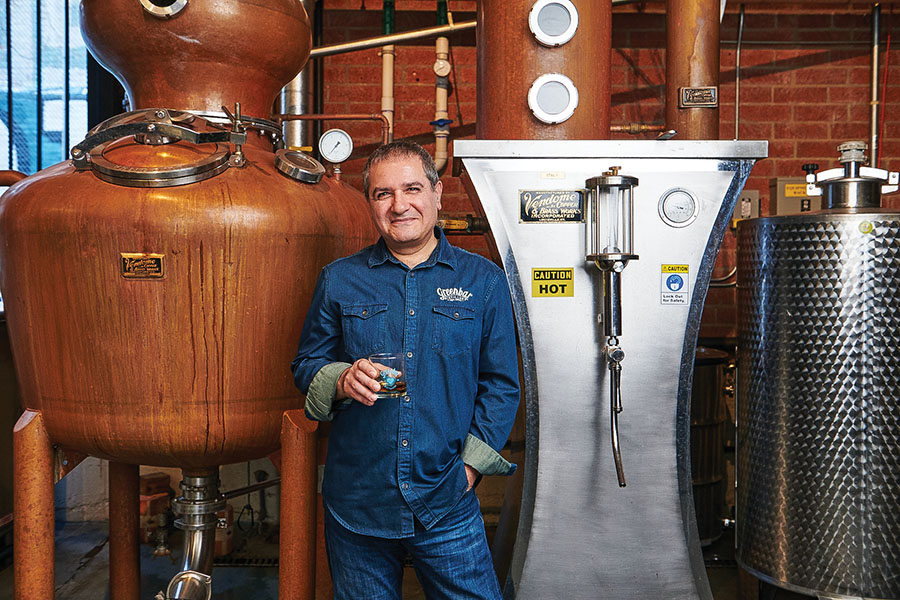
Act III: Because We Can Can Can
Greenbar’s cocktail classes, held in a bar that overlooks the bustling production floor, were in one way a flop. The problem was that class participants bought fewer bottles than tour and tasting guests did. “It made zero sense,” Melkon marvels. “Everyone seemed happy. Everyone seemed confident. Everyone left with half as much alcohol.” Greenbar guests did not want to make cocktails. Or, more accurately, they were easily dissuaded from doing so.
They reported that mixing drinks is too much work and that the components and tools cost too much money. Crucially, mixing drinks at home cuts into time that they would rather spend with guests. “Half wouldn’t even make a martini or a gin and tonic. These were not complex drinks that they did not want to make at home. Every single little excuse was an obstacle that would cause them to downshift to beer or wine — and that’s when the light went off.”
Greenbar would make those drinks for them.
American ready-to-drink (RTD) beverages in 2022 are a $5.6 billion market. According to the Distilled Spirits Council of the United States, 2021 revenue for spirits-based RTDs within the broader RTD market was $1.6 billion. At 42% over the previous year, these prepared cocktails were the fastest-growing spirits category, outpacing tequila and mezcal, Irish whiskey, and single malt Scotch. More than half of American RTD drinkers favor real spirits. For them, such drinks simply taste better than the alternatives.
It’s not hard to understand why. The RTD category is spattered with cack-handed drinks. Spirits slinger Joe Keeper shrugged off one ubiquitous hard seltzer: “You could pee in a can and it would taste better.” Khosrovian pointed out that the cheap, artificial tastes of many such RTDs are not surprising from makers who do not understand craft products.
Since the earliest kitchen trials, Greenbar has experimented with prepared drinks. The culinary infusions, the bitters and amari, all the distillates and decoctions in the portfolio comprise an expansive catalog of taste and aroma built over nearly twenty years. Although bulk spirits are readily available in the United States, highly flavored craft products are not. With their knowledge of making these sorts of modifiers, Khosrovian argues, many American distillers are ideally positioned to make RTD cocktails. “This is where craft distillers can shine,” he says, “because we already make these things.” Greenbar discontinued selling orange bitters, for example, but uses more now than it ever did when they were a stand-alone product because they are integral to its RTD lines.
The distiller argued that the strongest growth lies in premium drinks, those that use outstanding ingredients, whether they are alcoholic or not. Greenbar’s non-alcoholic RTDs are some of their strongest performers; their sales are projected to be 130% over last year. Litty agrees: “Our customers tell us what they want to drink. This is where they are right now. They want great-tasting cocktails that they can drink at home. We make nonalcoholic drinks the same way we make our alcoholic offerings. This is really about being nimble enough to offer our customers what they want.”
Greenbar’s national RTD success is partly due to its availability in supermarkets which, unlike many on-premise venues, remained open throughout the shutdowns. Amazon sells its canned cocktails as well as NA drinks online while its Whole Foods subsidiary sells the cans chilled and truly ready to drink. Mary Guiver, Global Principal Category Merchant for beer and spirits at Whole Foods, reports Melkon and Litty’s canned cocktails were “phenomenal out the gate.” Guiver was so impressed with Greenbar’s products that she nominated the distillery for the grocer’s Global Supplier of the Year in 2020.
It won.

Khosrovian is unequivocal about the importance of RTDs: “Inspiring craft distillers to get in on the act would be my number one goal.” Still, a crowded and swelling RTD market leaves little room for dabblers or dilettantes. His advice to distillers considering entering the market is to go all-in immediately or not at all. “If you have the interest and the space, and the risk tolerance, you can invest in a canning line like we did. And if you don’t, you can come up with a bottled RTD. The form factor doesn’t matter. Just make it easy for customers to enjoy a well-made drink.”
Epilogue
Twenty years on from toasts with barbaric drinks, Litty Mathew, that one specific, very picky customer, is pleased. “We’re always trying to improve and make things better,” she says. “I love everything that we come up with, and I’m really looking forward to having more to be pleased about.”

